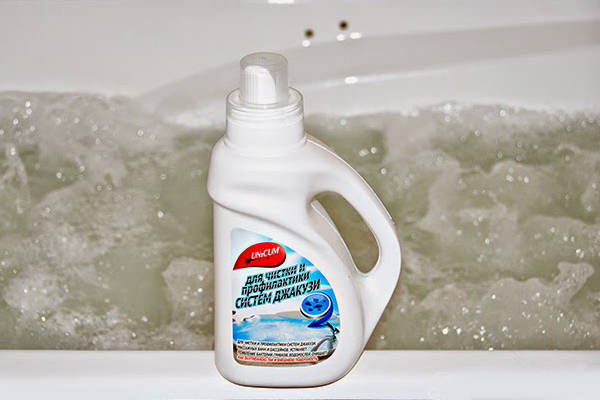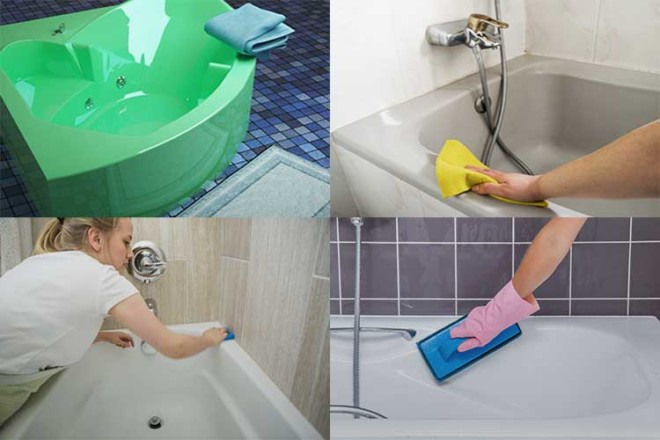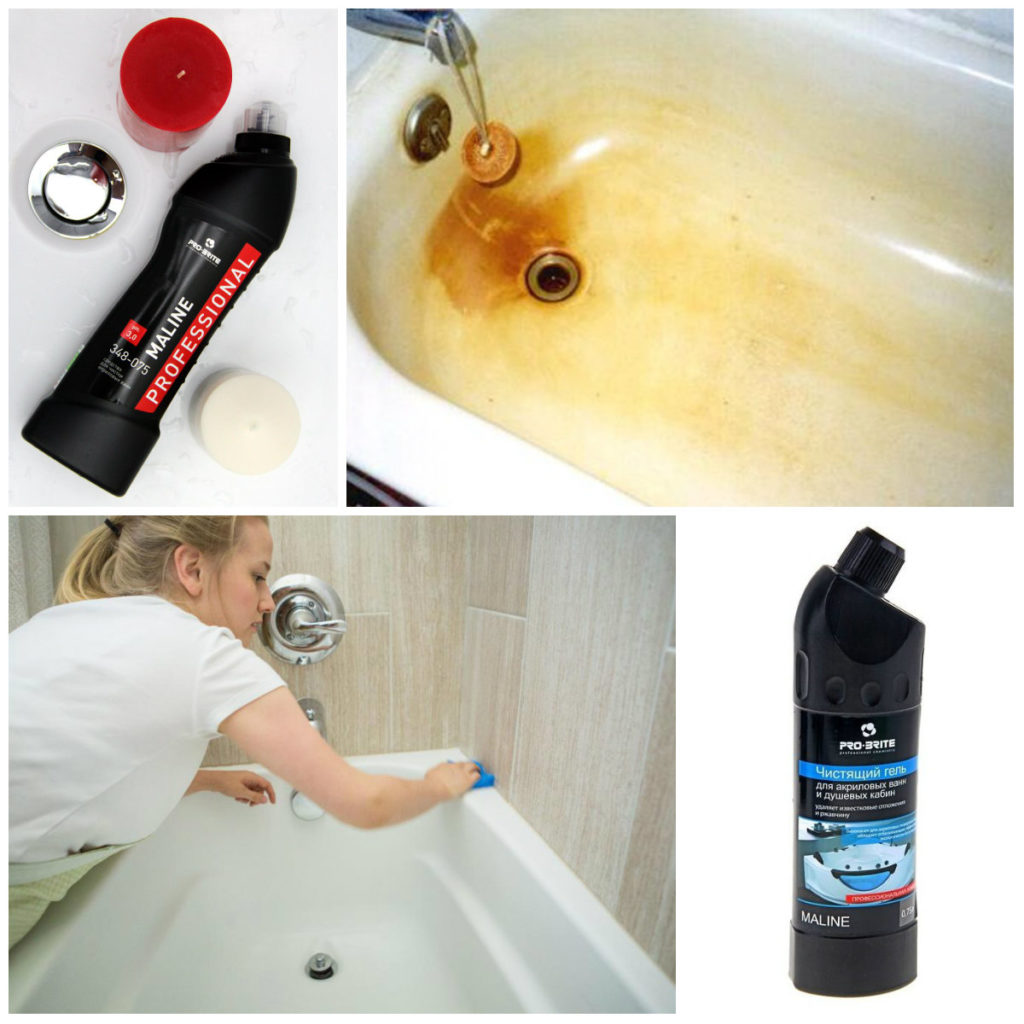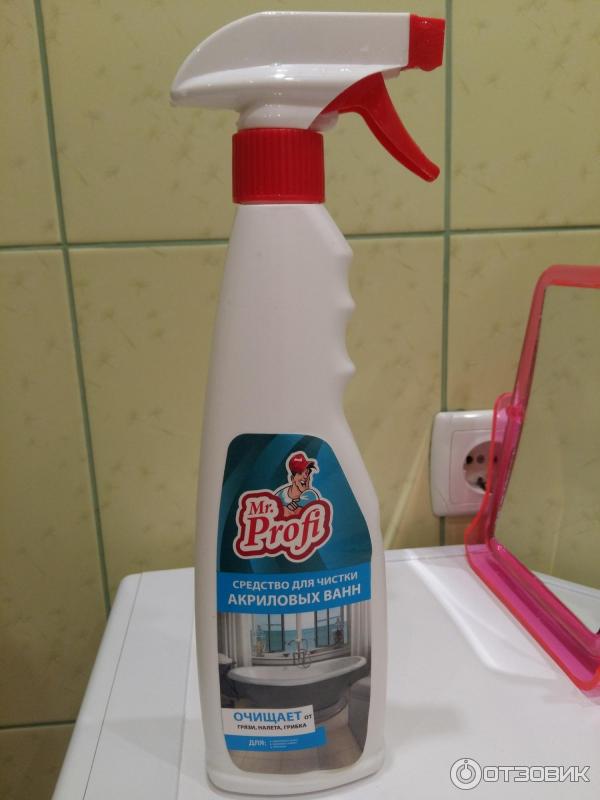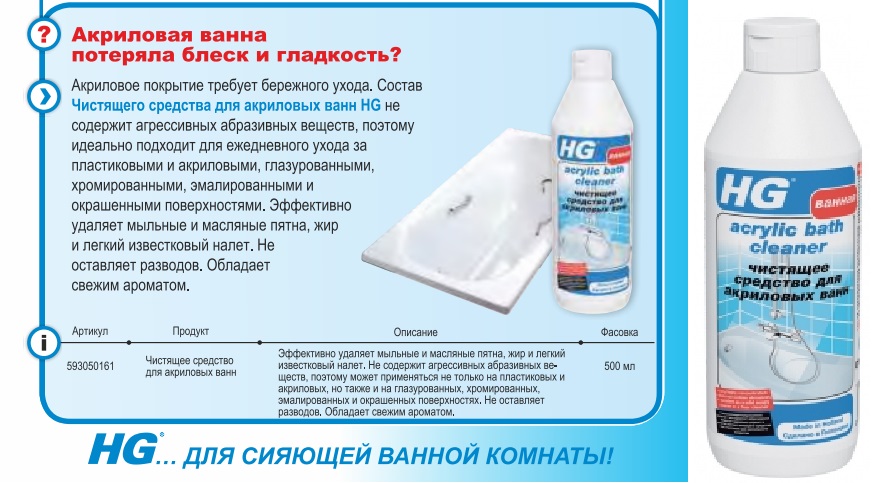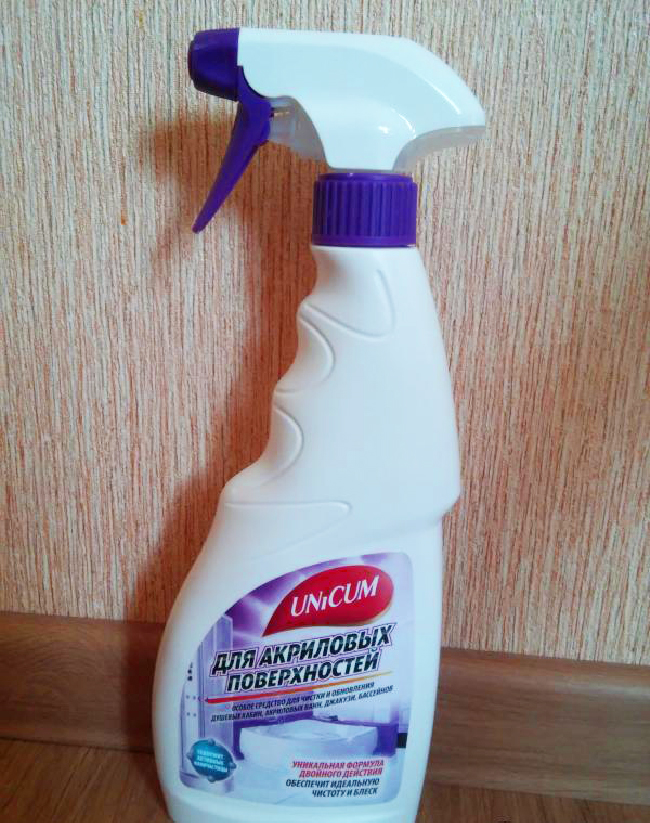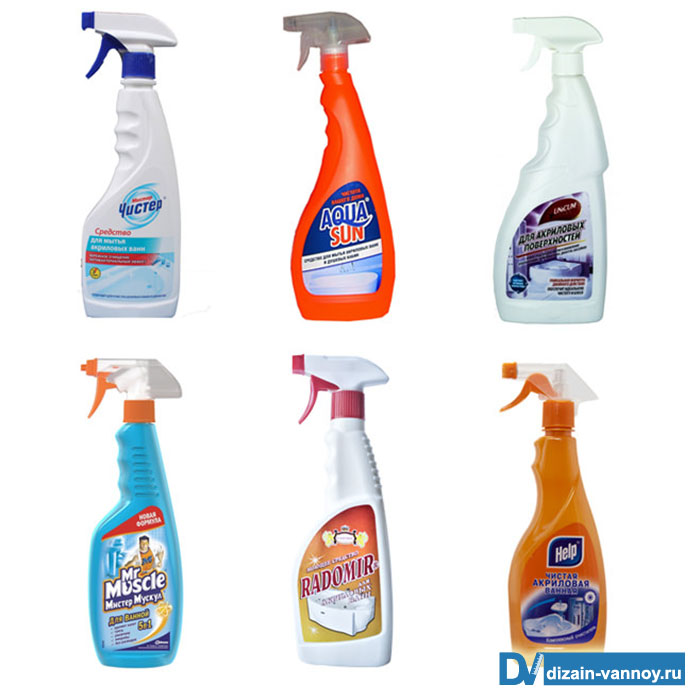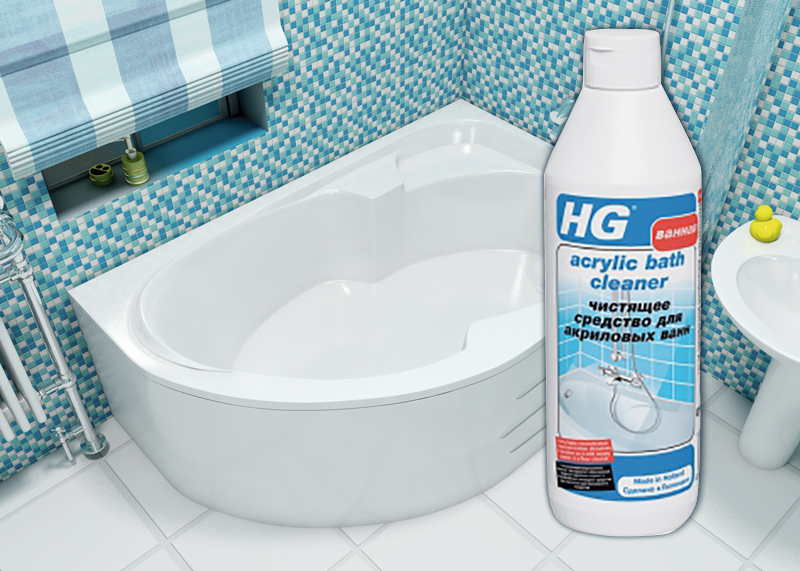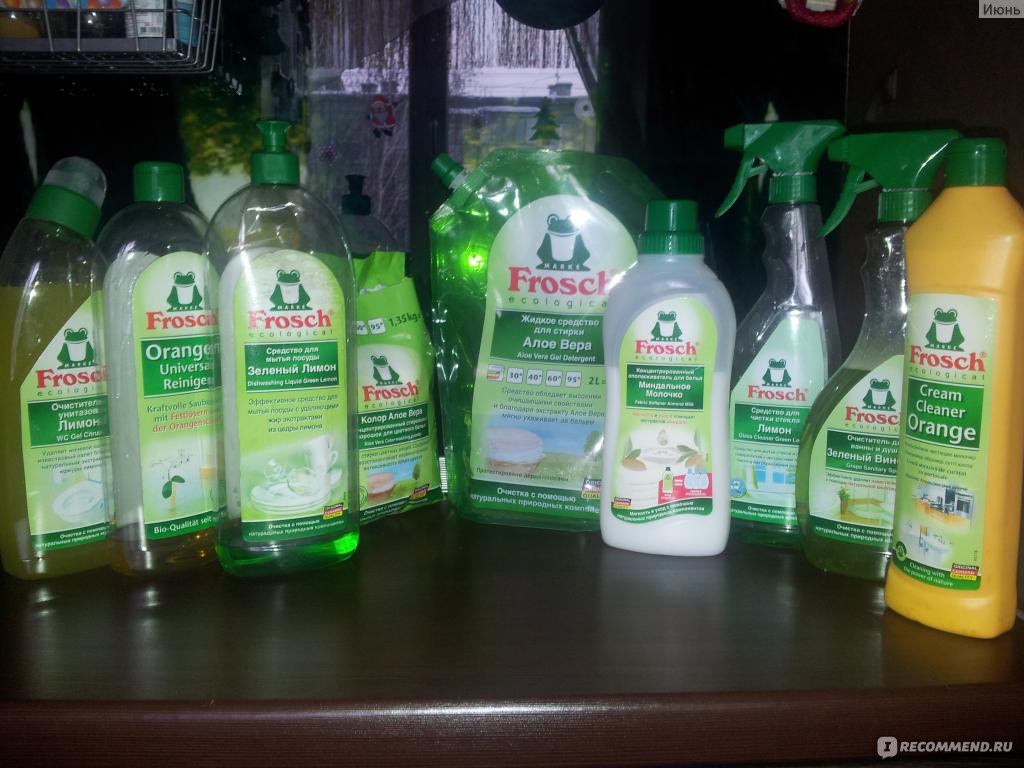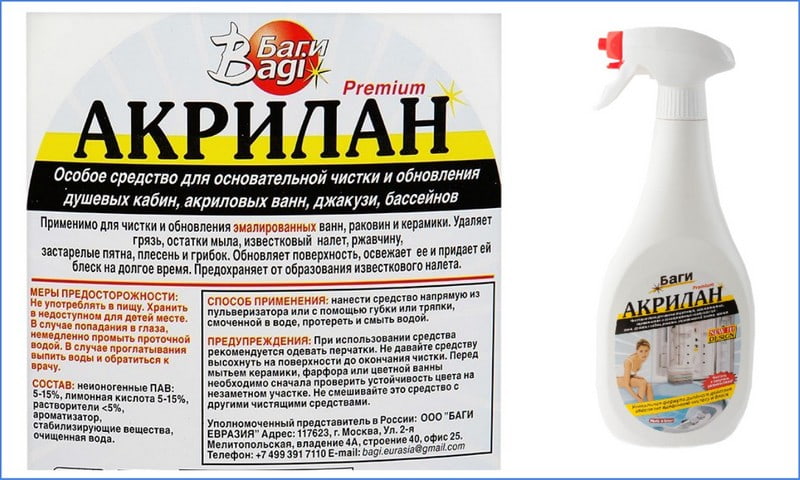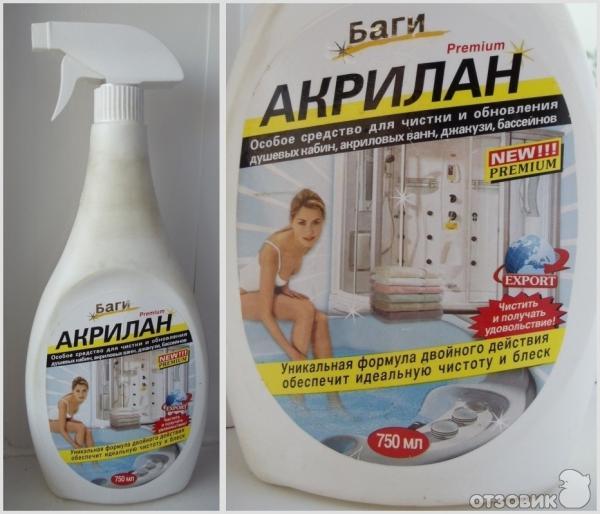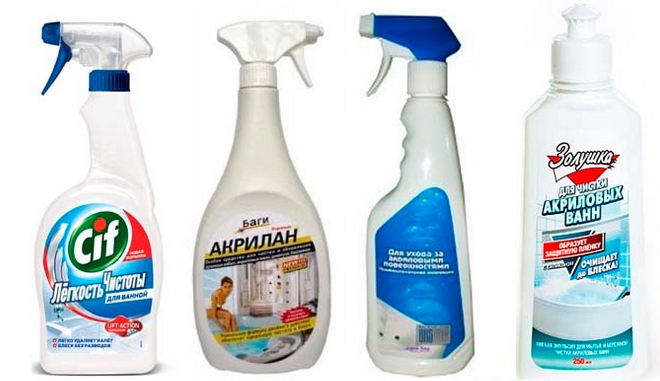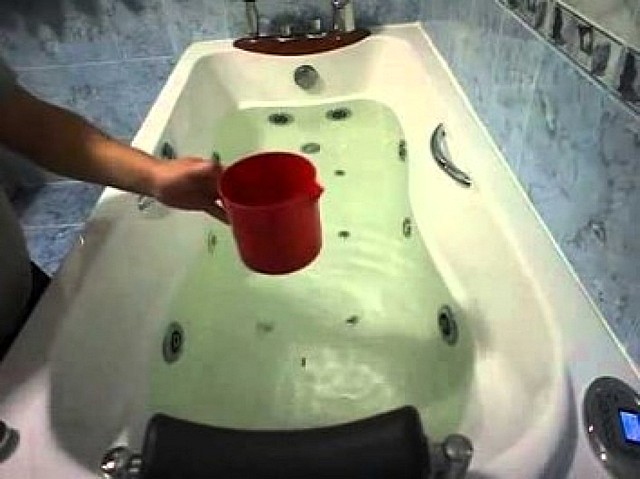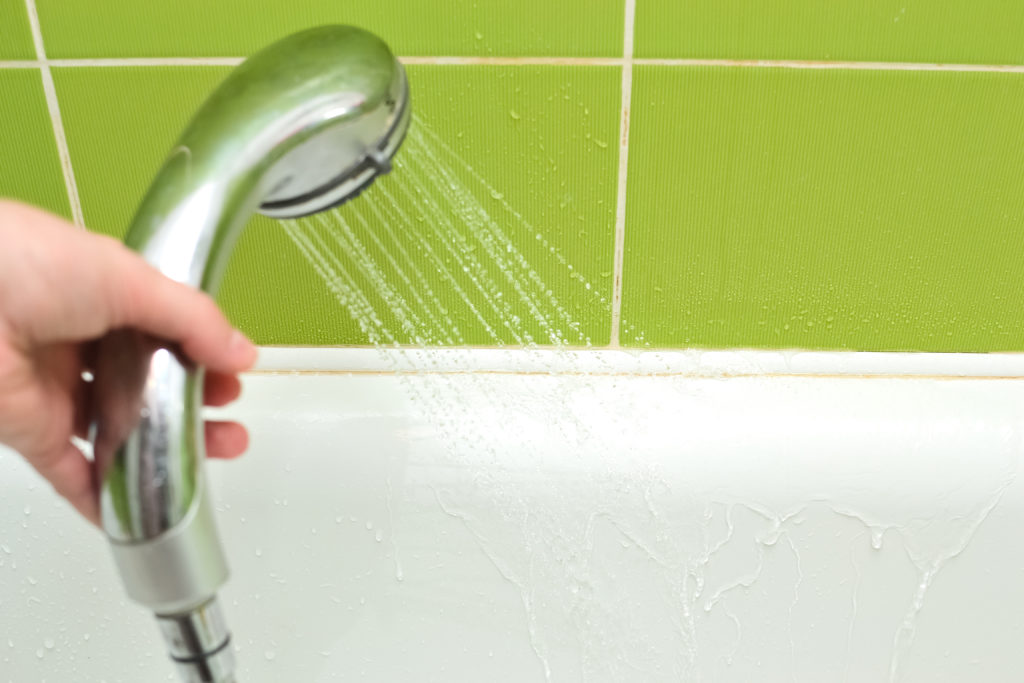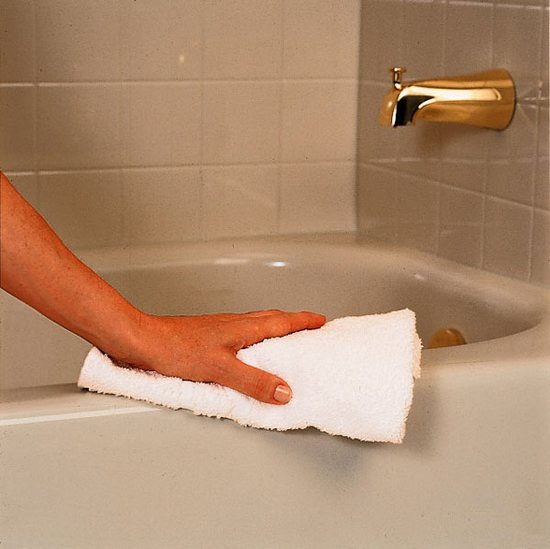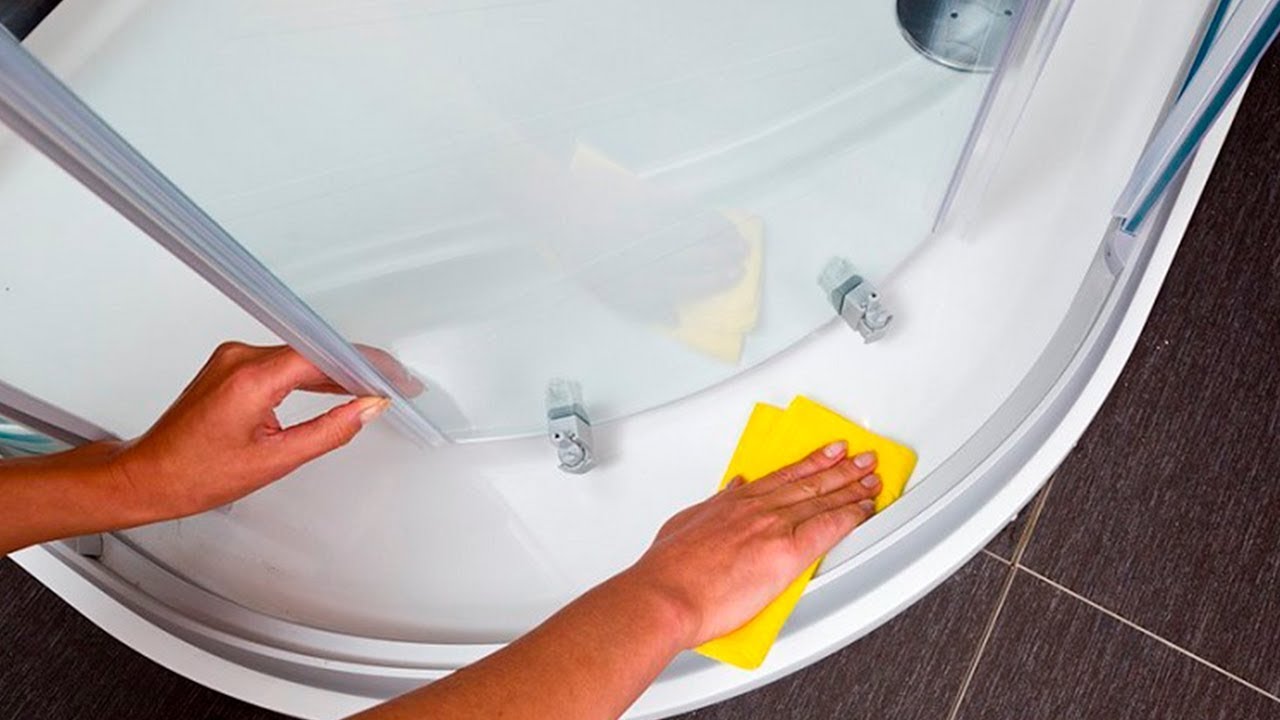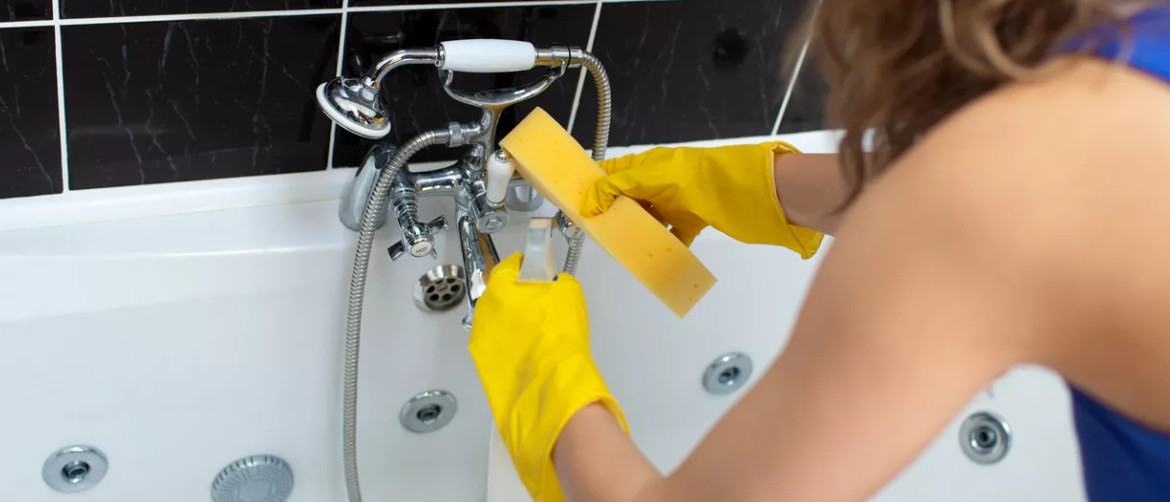How to care for
Use a soft cloth with a liquid soap to wash the bathtub. Wipe the surface with a dry cloth before cleaning to prevent the build-up of plaque that can be found in water with increased hardness. Use special wet wipes for bathrooms.
Use specialized acrylic gels. As a rule, they are applied to the surface and washed off after a few minutes. Alternatively, you can treat the bath with a mixture of water, vinegar and lemon juice.
General cleansing
Use a vinegar solution to tackle stubborn dirt. Pour in hot water with vinegar and leave to stand overnight. Rinse off in the morning. Then rinse and dry the container. The second method is to fill a container with warm water with a disinfectant dissolved in it.
How to remove rust, plaque and stains
Limescale can be removed by using lemon juice. Treatment with soda mixed in water will help against rust. Rust stains can be quickly and effectively treated by coating them with ammonia or hydrogen peroxide.
What to do with scratches
Special kits will help to deal with scratches on the surface, which, as a rule, are supplied with the bathroom, and are also sold in plumbing stores. The kit includes liquid acrylic or epoxy putty, and a spatula. Using such a set, you can easily and in a short time treat any, even deep damage.
Overview of folk remedies
In addition to specialized acrylic cleaners, folk remedies such as citric acid, soda and toilet soap are effective.
Lemon acid
With the help of citric acid, dirt and rust stains on the surface of the bath can be effectively and quickly treated. This substance is safe for the material and does not damage the bath.
Baking soda
A baking soda solution is also good for regular bath cleaning. You can use a mixture of baking soda and soda ash in equal proportions by gently applying it to a damp surface.
Toilet or baby soap
To maintain cleanliness, regular cleaning with a soft brush and regular toilet soap is usually sufficient. However, this method will not get rid of rust stains and limescale.
How to get rid of minor scratches and other damage?
Even with the most careful use of acrylic sanitary ware, it is often impossible to avoid scratches on their surface. In such damage, lime and rusty deposits can collect, which immediately visually distinguish these areas against the general background. To get rid of scratches, you can apply one of the existing methods for removing them.
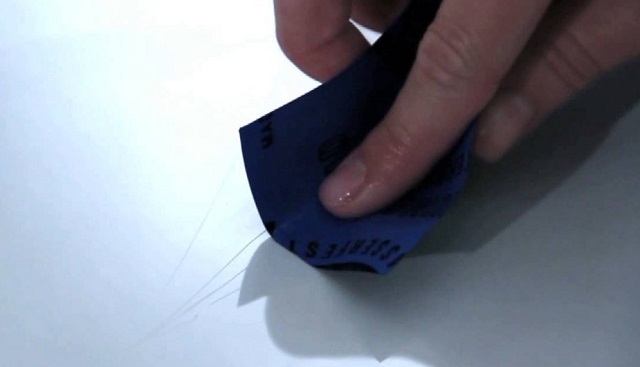 Sanding scratches with fine sandpaper
Sanding scratches with fine sandpaper
Shallow scratches can be removed in the same way as single rust spots by sanding the surface with fine-grained (P240 ÷ P280) emery paper. Then the leveled area is sanded with a polish specially designed for acrylic.
 Acrylic surface polish.
Acrylic surface polish.
Sometimes it is quite enough to apply only polish to scratches, without using preliminary abrasive action. The polishing paste is applied and rubbed into the surface intensively with a piece of felt in a circular motion. The process continues until the maximum smoothing of scratches and the applied composition.
 Repair kit for restoring damaged acrylic sanitary fixtures.
Repair kit for restoring damaged acrylic sanitary fixtures.
If deep damage occurs, a repair kit for acrylic plumbing accessories can help. It is recommended to purchase it together with the bathroom in order to immediately select the closest shade of color - later it will be much more difficult to do this. The kit contains a paste-like acrylic compound that hardens when applied to the surface of the bathtub. The paste is filled in the scratches and rubbed in in a circular motion with felt until smooth.
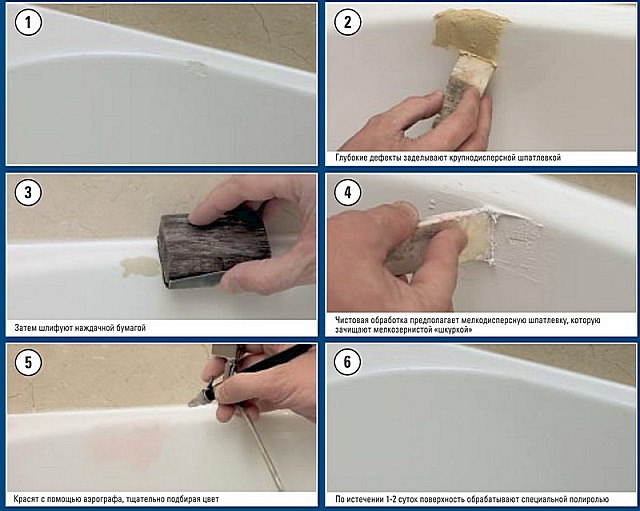 The process of repairing an acrylic bathtub using a putty.
The process of repairing an acrylic bathtub using a putty.
- Paste acrylic can even repair the through holes in the cast model of the bath, which can also form for one reason or another. To complete this procedure, you first need to clean the area to be repaired. Further, on the outside of the bath, several layers of high-quality waterproof adhesive tape are glued, which will become a barrier for the paste. The resulting hole is then filled with liquid acrylic and leveled with a plastic spatula. After that, the patch must be left until the paste hardens for two to three hours. Next, the acrylic is sanded with fine-grained sandpaper and polished with a piece of felt.
- The method of filling with acrylic can also be used in the case when it is necessary to remove deeply ingrained stains, after the elimination of which, depressions remain on the surfaces.
- Another option for filling through holes in the bath involves the use of polymer putty. They fill the hole formed with it and wait for it to dry completely. After that, acrylic paste is applied on top of the putty and leveled with a spatula. The dried paste is processed with fine-grained emery, then, if necessary, painted, and the final action is the final polishing of the area to a perfectly smooth state.
It is quite obvious that, if desired, the owners are able not only to carry out routine cleaning, but also to restore damaged areas of acrylic bathtubs without resorting to the help of a master.
Acrylic bathtub can be like new always - take care of it correctly
In fact, caring for an acrylic bathtub is completely uncomplicated. The only limitation is that you cannot use powder detergents to clean it. Despite the fact that acrylic has the highest surface strength among thermoplastics, it is still a household plastic, moreover, glossy, and the effect of any substance with an abrasive effect will negatively affect its appearance.
Use liquid or gel cleaners. Products specifically for acrylic products are ideal. There is no shortage of them. Such cleaning products are produced by any self-respecting manufacturer of household chemicals. The acrylic bathtub is resistant to dirt, however, it is advisable to periodically clean it thoroughly.
Apply the cleaner to the bathroom walls and let it sit for 5-10 minutes, then rinse. A soft sponge or cloth is recommended. Another reason why it is worth using products specifically designed for acrylic is the polishing effect that manufacturers put in them.

Cleaning the bathtub with a sponge
If you have not kept track and yellow streaks from water appeared on the bathtub, you still cannot resort to powder detergents. Moreover, no chlorine, acetone, ammonia, formaldehyde and other aggressive substances. You don't have to invent anything. There are special products for removing rust on acrylic surfaces. For the same reason, it is impossible to soak laundry in an acrylic bathtub, as washing powders contain chlorine or other bleach, contact of acrylic with which is undesirable.

Cleaning the bathtub with a special cleaning agent
Acrylic is indifferent to household acids, therefore, purely home conditions are not an obstacle to the fight against limescale (water stone). You can use acetic acid or citric acid.Pour water into the bath, dilute the acid and let sit for a few hours. Then drain the water and wipe the tub dry. If you carry out preventive measures against rust and limescale regularly, this will preserve the original appearance of the acrylic bath for ten years.
It is advisable not to use metal objects (buckets or basins). Metal containers can scratch the surface. If there is a need to use containers of a large volume, give preference to plastic ones.

Acrylic repair agent
The acrylic bathtub can be easily sanded or polished if needed. Repairability of acrylic products at a very high level
But such measures, subject to caution, you may need no earlier than after 10 years (manufacturer's warranty)
Acrylic bathtub care tips
The plastic of the acrylic bowl, unlike its metal counterparts, is softer and therefore more susceptible to mechanical stress, and acrylic is also afraid of contact with some chemical reagents in which it dissolves. These factors affect the care of an acrylic bathroom at home and the rules for its operation. Many users may find the following tips helpful:
- After washing, the bath is rinsed and wiped with a dry cloth - this prevents drips when water drops dry.
- It is recommended to thoroughly sanitize the bowl and adjacent walls using an acrylic bath cleaner every week. You can wash the bathtub with any Faery dishwashing compound or a soapy sponge and then wipe it dry.
- Once every six months, the bowl should be disinfected, for this it is filled with water and a disinfecting compound (Ravak, Tim Profi) is added, the water is allowed to stand for 20 minutes. and then drained.
- Acrylic is easy to scratch, so it is not recommended to put pots, metal buckets in the bathtub.
- When bathing pets (dogs, cats), avoid contact of their claws with the bowl.
- With noticeable scratches and stubborn stains that cannot be eliminated with chemistry, the damaged area is cleaned with fine sandpaper, and then polished using special materials and pastes. Since polishing work requires professional skills, knowledge of technology and the availability of special devices (materials), it is better to entrust such operations to a specialist.
- With a long service life, the inner surface of acrylic bathtubs loses its gloss and becomes dull, while it becomes dirty faster and more intensively, it is more difficult to care for it, and the procedure causes an increased consumption of cleaning gels and sprays. In this situation, you should think about polishing the entire surface of the bowl - this will improve the appearance, extend the service life and reduce the consumption of materials for cleaning.
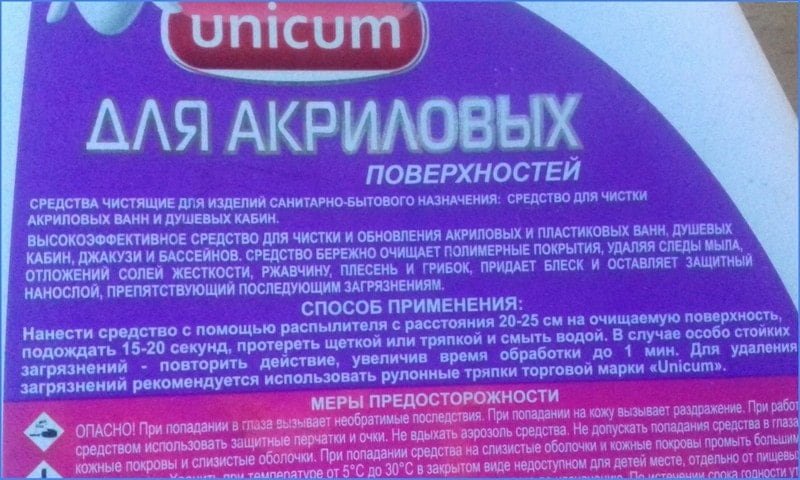 Unicum - instructions for use
Unicum - instructions for use
When deciding what can be used to wash an acrylic bathtub at home, they opt for folk methods of cleansing or household chemicals, a wide range of which is sold in the retail network. Of the self-made reagents, the most effective is a mixture of ammonia and hydropyrite, which is recommended on many Internet portals.
Not always expensive and advertised compositions for cleaning correspond in quality to their price, a good result can be achieved using domestic budget drugs (Cinderella, Chistin Sanitary), the cost of which is several times lower than the known analogues.
Basic rules of care
In fact, taking care of such products is not so difficult if you do it on an ongoing basis and do not allow obvious defects to appear. For example, a smooth surface resists dirt much better. But in the presence of scratches, dirt will clog into microscopic depressions in the places of greatest wear.
Try not to allow objects to fall into the bathtub or hit against its edges.A rubber mat can be used to protect the underbody from scratches, especially if you have pets that also need to shower from time to time.
Check out 7 rules to help you extend the life of your bathtub. It will also be useful: How to get rid of the smell of diesel fuel on clothes
It will also be useful: How to get rid of the smell of diesel fuel on clothes
Rule 1. Regularity
You need to clean the acrylic bath after each use. The minimum is to wipe off visible dirt. Do a thorough cleaning once a week to remove any traces of rust, grease and lime.
To prevent the build-up of deposits from the tap water, wipe the tub dry after washing.
Rule 2. "No" to abrasives
Never use abrasive products - they can damage the surface. Any powders and gels with coarse cleaning granules are absolutely not suitable. These products leave small scratches that will over time turn the surface of your bathroom into a continuous abrasion.
Choose special products that are labeled "for acrylic surfaces." It is not difficult to find them, they are sold in any supermarket.
Also useful: How to erase a handle from a leather sofa
Rule 3. "No" to solvents
Another prohibition for an acrylic bathroom is products containing strong acids, alcohol, acetone and ammonia. All substances acting as a powerful solvent must not come into contact with the polymer material.
In this regard, you will have to abandon some of the popular methods of cleaning surfaces from dirt and plaque. In particular, a solution with ammonia, vinegar essence is not suitable. Do not spill nail polish remover on acrylic! But some glass sprays, as well as a solution of lemon and vinegar, may well be useful for cleaning.
It will also be interesting: How to clean brass at home
Rule 4. Only soft materials
The bathroom should only be handled with soft materials. You can throw brushes, hard sponges and scrapers away. Even a microfiber cloth is poorly suited for this purpose.
The best way to clean an acrylic bathroom is with a cotton rag, soft, lint-free cloth, or a foam sponge. Anything that cannot scratch the surface of the product will do.
Another interesting article: How long fresh mushrooms are stored in the refrigerator
Rule 5. Protection against high temperatures
An acrylic bathroom is not only afraid of abrasives and solvents. It also needs to be protected from high temperatures. This does not mean that you only have to take an ice shower. Just limit the presence of potentially hazardous items in this room. Move the curling iron, tongs and similar tools away from the acrylic surface so as not to accidentally melt it.
If you decide to arrange a "romantic" with candles, make sure that they have a stand that will not heat up. In general, it is better to remove the fire away from the bath itself.
It will also be interesting: How to clean a glass-ceramic plate
Rule 6. Wipe dry
This rule is rather a wish. It is too tedious to wipe off every drop of water that gets on the coating. But after you take a shower, it is advisable to lightly clean the bathroom with soap and wipe off any remaining water.
Such a procedure will not take too much time and effort, but you will save acrylic from the formation of a yellow coating from dirt and rust. In addition, when dry, hard tap water leaves traces in the form of limescale, so it is not better to get rid of it in advance.
It will also be interesting: How to clean a suede jacket at home
Rule 7. Polish
From time to time, you need to rub the bath more thoroughly.To preserve the glossy surface and eliminate the smallest scratches, use a special acrylic polish and a soft cloth to apply it. You can use wax products just like you would for furniture.
Surface restoration
Small scratches (up to 1 mm deep) can be easily hidden by rubbing the bathtub with a polishing compound or simply sanding with a piece of felt. This does not require serious expenditure of energy.
Deeper lesions need to be repaired using liquid acrylic, available from your hardware store. A little of the composition is applied to the damaged area and sanded after hardening.
Trowelable liquid acrylic has a pasty consistency and is produced not only in white, but also tinted. This allows you to choose a repair compound for a bath of any color shade.
Liquid acrylic allows you to eliminate even serious cracks and holes. To do this, adhesive tape is glued on the outside of the bowl (a barrier against the leakage of the repair compound) and the damaged area is poured with liquid material.
The damaged area is preliminarily cleaned of dirt and degreased. After the liquid acrylic has solidified, the surface is sanded to remove irregularities, and polished to a shine.
Please note: this method of restoring holes is only suitable for pure acrylic bowls. It cannot be used for plastic models with an acrylic layer on top.
Cleaning products overview
Each housewife thinks about how to clean an acrylic bathtub. Fortunately, there are currently a huge number of special tools. "Akrilan" is a cleaning foam that easily removes various types of dirt (soap stains, limescale, rust). The tool will easily deal with all types of stains. The advantage of this product is the formation of a protective film on the acrylic surface, which prevents further plaque accumulation. But never leave the foam on the surface of acrylic products until completely dry, and do not mix it with other products. Use gloves when cleaning. Keep away from children.
Cif is the optimal cleaning agent for all sanitary ware. The composition does not contain abrasive substances. Therefore, the acrylic surface is not threatened with loss of gloss and integrity. The product is available in several forms - cream, paste, spray.
Bass - liquid for cleaning plumbing in the bathroom. Suitable for daily use.
"Tim-Profi" is a detergent designed for cleaning acrylic surfaces. Among the main advantages are environmental friendliness, the ability to destroy unpleasant odors, and the removal of significant contaminants. The product gives the cleaned surface a shine, and also forms a special protective layer.
Cinderella is an effective product for cleaning acrylic products. Ideal for those who cannot decide what to clean an acrylic bathtub. Among the disadvantages is a pungent odor that appears directly when spraying. In the process of processing, it is recommended to use not only gloves, but also a mask. The product must be sprayed onto the surface of the acrylic bathtub and left for 7 minutes. After the specified time, rinse the drug with running water, wipe the bath with a soft napkin.
Chister is an acrylic bathtub cleaner that is also suitable for other plumbing items. Ideally removes limescale, rust, grease and soap stains, gently cleans the surface without causing mechanical damage. The preparation contains an acrylic polymer, which acts as a barrier for further adhesion of dirt to the bath. The product protects against the appearance of fungi and bacteria. The bath will delight the owners with cleanliness in a couple of minutes.
Products for the care of acrylic bathtubs, what to choose?
A bath, like any other acrylic product, requires the use of special care products.Cleaning this material negates the use of most products that are suitable for others. Acrylic cleaners should be soft to the touch, free of lumps and powdery impurities.
Before using any detergent (even if it is indicated on the packaging that it is suitable for acrylic), you should check the possibility of its use. To do this, it is worth trying the product on a small area of the bath.
If, after using it, the surface has not lost its luster, then it is suitable and is not a fake.
Creamy compositions are most suitable for washing acrylic, which should be used according to the instructions. The most popular care products for acrylic surfaces are as follows:
All of the above tools have found wide acceptance among users of modern plumbing. According to statistics, it is these compositions that are most often bought.
In the reviews about them, you can hear and read that the products remove rust / plaque / stains and dirt well, do not scratch the surface, are well weathered, without leaving an unpleasant odor in the bathroom for a long time, and are easily washed off. If you did not have time to purchase a special product for the care of your plumbing, then make it yourself. This is possible with just a few tools at hand.
To prepare a composition for the care of acrylic, you will need the following ingredients: 15-20 grams of baby or other soap (without additives), half a liter of boiling water, 100 grams of soda, 10-15 drops of aromatic oil (optional).
- Rub the soap with a coarse grater.
- Pour boiling water over it and let it dissolve completely.
- Add baking soda (in small portions) and stir until no "white powder" remains.
- Add aromatic oils to the contents.
You can apply the resulting composition immediately after all the conditions are met.
To wash the bath, take a large amount of the resulting creamy mass, apply it in a thick layer to the surface and leave for half an hour (or more).
After the time has elapsed, wipe everything with a sponge or soft cloth, rinse well and wipe dry.
We recommend watching a video in which it is shown at home:
As you can see, the acrylic surface needs constant care just like other sanitary ware, the only difference is in the means needed for this.
Follow the care requirements for your acrylic sanitary ware, and it will serve you for a long time, delighting you with its shine, cleanliness and smooth surface.
How is an acrylic bathroom taken care of at home?
The acrylic material requires almost the same maintenance as the enamel coating of sanitary ware. So what do you need to know about caring for an acrylic bathroom?
- The shine is gone. To restore the effect of gloss, it is necessary to polish the surface with a product applied to a soft cloth (napkin).
- There are stains / streaks. The dirt should be cleaned with products used for smooth materials and surfaces.
- A water stone formed. This problem can be dealt with with improvised means - citric acid or acetic acid (7%). To remove limescale, you need one fifteen-gram pack of acid or one and a half liters of vinegar.
- There are scratches. To return the bathtub to smoothness, you need to: clean up all scratches with fine-grained sanding paper, rinse and polish (for deep scratches, you need to polish with liquid acrylic).
- Rust has formed. You can get rid of "red spots" with the help of special products (from rusty deposits), which are suitable for acrylic (see instructions).
To clean your bath with vinegar, follow these steps:
- fill the bathtub with warm water;
- add vinegar / acid;
- stir;
- leave overnight, preferably 12-14 hours;
- pour everything out and rinse thoroughly with a shower;
- wipe dry with a soft cloth.
In addition to the above reasons requiring the care of the acrylic bathroom, preventive measures should be taken: rinse with warm water, wipe dry, disinfect (at least once a year) and adhere to the tips listed below.
Tips for the care of an acrylic bathroom:
- When using any means for cleaning the surface of the bathroom, be sure to use rubber gloves, ventilate the room afterwards and do not forget about accuracy - getting funds on the mucous membrane can be dangerous.
- Do not use care products for other purposes. Eliminate all detergents containing chlorine, ammonia, powder, acetone and other aggressive components.
- Use only a soft cloth or sponge, no abrasives that can scratch the surface.
- After cleaning the bath with any means, thoroughly rinse the surface.
- Make sure that water from the tap does not drip, which can lead to rust.
- If you need to bathe your pets or do the dishes, cover the bottom with something. Try not to put metal objects in the bath.
- Do not use very hot water.
Tortured condensation on the toilet cistern? Read here.
How to connect an automatic machine if there is no running water in the house?
What to look for when choosing a kitchen faucet?




